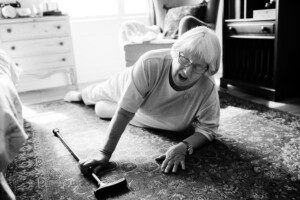There’s a change you can make in walking that can reduce frailty or help delay age related frailty. This change isn’t even big, but the results sure are.
Frailty is a medically recognized condition that affects many older adults, making them more susceptible to everyday challenges and increasing the likelihood of falls and hospitalization.
Frailty can cause loss of independence. But senior age people can combat frailty.
This condition is not a sudden development but rather, a gradual decline in physical resilience, often signaled by key warning signs such as:
- Unintentional weight loss
- Slower movements
- Muscle weakness
- Chronic fatigue
- Low physical activity levels
Most of these symptoms are directly linked to a person’s level of physical activity.
Walking stands out as one of the most practical and impactful ways for older adults to enhance their health and preserve mobility and independence.
Difficulty with walking, needless to say, will severely affect independence.
However, just how fast should people of elderly age walk to truly benefit and help stave off a medically frail state?
Traditionally, healthcare providers have used the “talk test” to determine appropriate walking intensity.
The idea is simple: Walk at a pace that makes singing difficult but still allows for normal conversation.
While intuitive, this method is subjective and often hard to apply consistently across different individuals and settings.
To provide more concrete guidance, researchers at the University of Chicago Medicine conducted a study examining this situation.
The study found that walking just a bit faster — specifically, increasing your pace by 14 steps per minute over your normal speed — can lead to measurable improvements in physical function, particularly for older adults who are already showing signs of frailty or are at risk of becoming frail.
Why focus on walking cadence?
Walking cadence, which refers to the number of steps taken per minute, is an easy-to-understand and objective way to measure how intensely someone is walking.
Dr. Daniel Rubin, an anesthesiologist at UChicago Medicine, became interested in cadence through his work evaluating older patients preparing for surgery.
In the paper Dr. Rubin explains that older people often face higher risks from surgery.
Historically, physicians have relied upon questionnaires to assess a patient’s physical fitness.
But, as Dr. Rubin continues, this isn’t very objective at all for evaluating risk.
That belief led to a deeper investigation into walking cadence as a practical marker of health and resilience.
Benefits of Walking Faster
In a secondary analysis stemming from a randomized controlled trial, Dr. Rubin and his team worked with senior age adults categorized as frail or pre-frail.
Participants took part in supervised walking programs in their senior living communities.
Each participant wore a thigh-mounted device to track walking cadence.
One group was encouraged to walk at their normal, comfortable speed, while the other was asked to walk “as fast as was safely possible.”
The results were striking. Those who increased their cadence by at least 14 steps per minute, hitting around 100 steps per minute, experienced noticeable gains in physical performance.
These improvements were assessed using standard functional tests, including walking longer distances without fatigue.
“For someone dealing with frailty, being able to run errands without needing to sit down or rest can make a world of difference,” Dr. Rubin says in the paper.
Incorporating Faster Walking into Everyday Life
The broader takeaway from this research is that walking, even at a casual pace, can offer significant health benefits for older men and women.
But for those who can safely do so, even modestly increasing walking speed provides even greater returns.
• To get started, measure your usual walking pace in steps per minute — this becomes your personal baseline.
• From there, try boosting your cadence by about 14 steps per minute to reach a brisk yet comfortable pace.
• Use a metronome app to help maintain a steady rhythm.
• Increase your pace even over the short distances in everyday life, such as from car to convenience store; across a parking lot; to the end of the driveway to get the mail; from point A to point B at the place you volunteer or work at; to go from one room to another in your house.
• In short, anytime you’re ambulating on your feet, pick up the pace. Don’t be a slow poke.
If you’ve already been using a treadmill, do NOT hold on except during moments when you need more stability such as when adjusting the settings.
The machine’s program might keep telling you to hold on for heart rate.
If you want a momentary heart rate, then take it. But then release your hands and swing your arms naturally.
If the program keeps telling you to hold on, ignore it. Holding onto a treadmill mimics using a walker!
Holding onto a Treadmill Is Like Using a Walker, Will Make You Older
![]()
Lorra Garrick is a former personal trainer certified by the American Council on Exercise. At Bally Total Fitness, where she was also a group fitness instructor, she trained clients of all ages and abilities for fat loss and maintaining it, muscle and strength building, fitness, and improved cardiovascular and overall health.










































